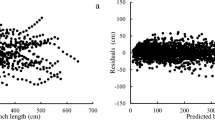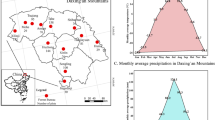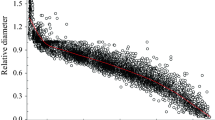Abstract
Key message
We developed the generalized branch diameter and length models using the multi-level nonlinear mixed-effects techniques for the natural Dahurian larch ( Larix gmelini ) forest in northeast China.
Abstract
Dahurian larch (Larix gmelini) is the most commercially cultivated timber species in northeastern China due to its ecological prevalence and its superior wood attribute. However, its timber quality was largely driven by the crown architecture, i.e., the number, size and distribution of branches. The majority of branch-level models in the literature are focused on planted forests, which have substantially different crown architecture than that grown in natural mixed forests. Therefore, the goal of this investigation was to develop branch diameter and length models for Dahurian larch that are grown in natural mixed forests. A multi-level nonlinear mixed-effects model technique, including the fixed-effects, random-effects, variance functions and correlation structures, was employed to develop the branch growth models. The results suggested that the cumulative branch diameter and length were both increased with the increases of branch depth into the crown. Diameter at breast height (DBH) had significant positive influences on the branch size; however, tree height (HT) produced negative influences on the branch size, i.e., larger DBH and smaller HT could lead to larger branch size. Model fitting and validation results confirmed that we should avoid developing over-complex models from the perspective of application. As for the branch diameter and length models in our study, addressing the stand and tree level effects as random component were quite reliable and accurate for predicting the branch growth process of Dahurian larch in northeastern China.




Similar content being viewed by others
References
Anning AK, McCarthy BC (2013) Competition, size and age affect tree growth response to fuel reduction treatments in mixed-oak forest of Ohio. For Ecol Manag 307:74–83
Barbeito I, Collet C, Ningre F (2014) Crown responses to neighbor density and species identity in a young mixed deciduous stand. Trees 28:1751–1765
Beaulieu E, Schneider R, Berninger F, Ung CH, Swift DE (2011) Modeling jack pine branch characteristics in Eastern Canada. For Ecol Manag 262:1748–1757
Calama R, Montero G (2005) Multilevel linear mixed model for tree diameter increment in stone pine (Pinus pinea): a calibrating approach. Silva Fenn 39(1):37–54
Corral-Rivas S, Álvarez-González JG, Crecente-Campo F, Corral-Rivas JJ (2014) Local and generalized height-diameter models with random parameters for mixed, uneven-aged forests in Northwestern Durango, Mexico. For Ecosyst 1(6):1–9
Courbet F, Hervé JC, Klein EK, Colin F (2012) Diameter and death of whorl and interwhorl branches in Atlas cedar (Cedrus atlantica Manetti): a model accounting for acrotony. Ann For Sci 69:125–138
CSFA-FRM (Department of Forest Resources Management of China State Forestry Administration) (2010) Forest resources statistics of China. China Forestry Publishing House, Beijing (in Chinese)
Dahle GA, Grabosky JC (2010) Allometric patterns in Acer platanoides (Aceraceae) branches. Trees 24:321–326
Dong LB (2013) Visualization of individual tree for Pinus koraiensid plantation based on mixed-effects model. Dissertation, Northeast Forestry University (in Chinese with English abstract)
Fang Z, Bailey RL (2001) Nonlinear mixed effects modeling for slash pine dominant height growth following intensive silvicultural treatments. For Sci 47:287–300
Fortin M, Bedard S, Deblois J, Meunier S (2008) Accounting for error correlations in diameter increment modeling: a case study applied to northern hardhood stands in Quebec, Canada. Can J For Res 38:2274–2286
Fu LY, Sun H, Sharma RP, Lei YC, Zhang HR, Tang SZ (2013) Nonlinear mixed-effects crown width models for individual trees of Chinese fir (Cunninghamia lanceolata) in south-central China. For Ecol Manag 302:210–220
Garber TG, Maguire DA (2003) Modeling stem taper of three central Oregon species using nonlinear mixed effects models and autoregressive error structures. For Ecol Manag 179:507–522
Gu HY, Yang K, Li CY, Yang FJ (2001) Establishment of standardized site index of needle-leaved forest and its application in application in evaluation of site quality in Daxing’an Mountains. J For Res (Harbin China) 12(2):128–132
Hayes JP, Chan SS, Emminghan WH, Tappeiner JC, Kellogg LD, Bailey JD (1997) Wildlife response to thinning young forests in the Pacific. N W J For 95(8):28–33
Hayes JP, Weikel JM, Huso MMP (2003) Response of birds to thinning young Douglas-fir forests. Ecol Appl 13:1222–1232
Hein S, Aaron RW, Kohnle U (2008) Branch characteristics of widely spaced Douglas-fir in south-western Germany: comparisons of modeling approaches and geographic regions. For Ecol Manag 256:1064–1079
Jiang LC, Zhang R, Li FR (2012a) Modeling branch length and branch angle with linear mixed effects for Dahurian larch. Scientia Silvae Science 48(5):53–60 (in Chinese with English abstract)
Jiang LC, Li FR, Zhang R (2012b) Modeling branch diameter with linear mixed effects for Dahurian larch. For Res 25(4):464–469 (in Chinese with English abstract)
Jin LY, Gu XF, Zhang XC, Fan Y, Sun FY (1995) Study on the prevention quota model of Coleophora dahurica Falk. J Beijing For Univ 17(3):67–72 (in Chinese with English abstract)
Kantola A, Mäkelä A (2004) Crown development in Norway sprice [Picea ablies (L.) Karst.]. Trees 18:408–421
Jordan L, Daniels RF, Clark A, He R (2005) Multilevel nonlinear mixed-effects models for the modeling of earlywood and latewood microfibril angle. For Sci 51(4):357–371
Lappi J, Bailey RL (1988) A height prediction model with random stand and tree parameters: an alternative to traditional site index methods. For Sci 38(2):409–429
Lejeune G, Ung CH, Fortin M, Guo XJ, Lambert MC, Ruel JC (2009) A simple stem taper model with mixed effects for boreal black spruce. Eur J For Res 128:505–513
Maguire DA, Kershaw JA, Hann DW (1991) Predicting the effects of silvicultural regime on branch size and crown wood core in Douglas-fir. For Sci 37:1409–1428
Mäkelä A, Vanninen P (2001) Vertical structure of Scots pine crowns in different age and size classes. Trees 15:385–392
Mäkinen H (1996) Effect of inter tree competition branch characteristics of Pinus sylvestris families. Scand J For Res 11(4):129–136
Mäkinen H, Ojansuu R, Sairanen P, Yli-Kojola H (2003) Predicting branch characteristics of Norway spruce (Picea abies (L.) Karst.) from simple stand and tree measurements. Forestry 76(5):525–546
Meredieu C, Colin F, Hervé JC (1998) Modeling branchiness of Corsican pine with mixed-effect models. Ann Sci For 55:359–374
Nelson AS, Weiskittel AR, Wagner RG (2014) Development of branch, crown, and vertical distribution leaf area models for contrasting hardwood species in Maine, USA. Trees 28:17–30
Pinheiro JC, Bates DM (2000) Mixed-effects models in S and S-Plus. Springer, New York
Pretzsch H, Biber P, Dursky J (2002) The single tree-based stand simulator SILVA: construction, application and evaluation. For Ecol Manag 162:3–21
Roeh RL, Maguire DA (1997) Crown profile models based on branch attributes in coastal Douglas-fir. For Ecol Manag 96:77–100
Sattler DF, Comeau PG, Achim A (2014) Branch models for white spruce (Picea glauca (Moench) Voss) in naturally regenerated stands. For Ecol Manag 325:74–89
S-PLUS Institute (2008) S-PLUS 8.0 for windows user’s guide. S-PLUS Institute, Inc
Trasobares A, Pukkala T, Miina J (2004) Growth and yield model for uneven-aged mixtures of Pinus sylvestris L. and Pinus nigra Arn. in Catalonia, north-east Spain. Ann For Sci 61:9–24
Vonesh EF, Chinchilli VM (1997) Linear and nonlinear models for the analysis of repeated measurement. Marcel Dekker, New York
Vose JM, Dougherty PM, Long JN, Smith FW, Gholz HL, Curran PJ (1994) Factors influencing the amount and distribution of leaf area of pine stands. Ecol Bull 43:102–114
Wang Y, LeMay VM, Baker TG (2007) Modeling and prediction of dominant height and site index of Eucalyptus globulus plantations using a nonlinear mixed-effects model approach. Can J For Res 37:1390–1403
Weiskittel AR, Maguire DA, Monserud RA (2007) Response of branch growth and mortality to silvicultural treatments in coastal Douglas-fir plantations: implications for predicting tree growth. For Ecol Manag 251:182–194
Woollons RC, Haywood A, McNickle DC (2002) Modeling internodes length and branch characteristics for Pinus radiata in New Zealand. For Ecol Manag 160:243–261
Wu ZY (2010) Flora of China illustrations-7. Science Press, Beijing (in Chinese)
Yang YQ, Huang SM (2011) Estimating a multilevel dominant height-age model from nested data with generalized errors. For Sci 57(2):102–116
Zhang L, Moore JA, Newberry JD (1993) A whole-stand growth and yield model for interior Douglas-fir. West J Appl For 8(4):120–125
Zhao DH, Wilson M, Borders BE (2005) Modeling response curves and testing treatment effects in repeated measures experiments: a multilevel nonlinear mixed-effects model approach. Can J For Res 35:122–132
Acknowledgments
We would like to thank the faculty members and students of the Department of Forest Management, Northeast Forestry University (NEFU), P.R. China, who collected the data for this study in the Pangu forest farm in 2011. We acknowledge the financial support by the National Science and Technology Pillar Program during the 12th Five-year Plan Period, Project # 2012BAD22B0202 and Project # 2011BAD37B02. We also appreciate the valuable comments and the constructive suggestions from two anonymous referees and the Editor.
Author information
Authors and Affiliations
Corresponding author
Ethics declarations
Conflict of interest
The authors declare that they have no conflict of interest.
Additional information
Communicated by E. Priesack.
Rights and permissions
About this article
Cite this article
Dong, L., Liu, Z. & Bettinger, P. Nonlinear mixed-effects branch diameter and length models for natural Dahurian larch (Larix gmelini) forest in northeast China. Trees 30, 1191–1206 (2016). https://doi.org/10.1007/s00468-016-1356-y
Received:
Accepted:
Published:
Issue Date:
DOI: https://doi.org/10.1007/s00468-016-1356-y




